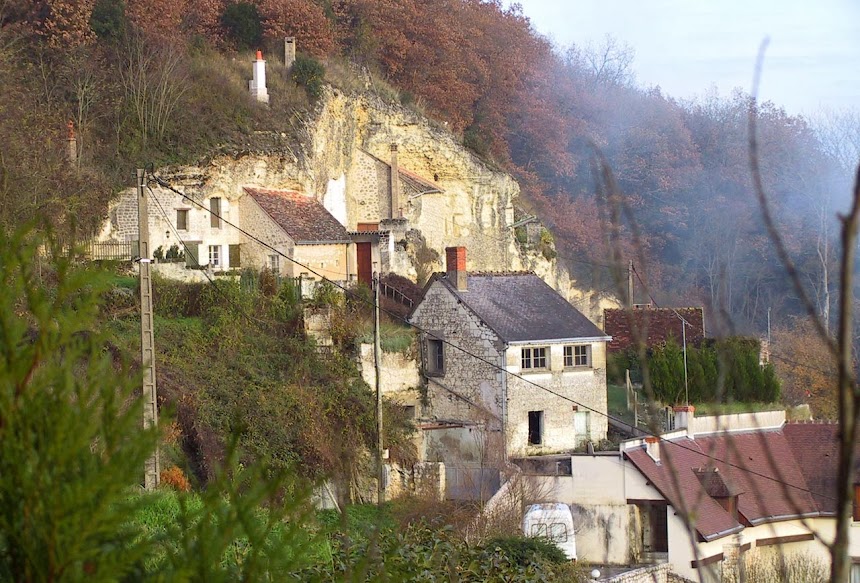Bourré (pop. 750) is a village on the north side of the Cher River. It's just east of the town of Montrichard. Bourré's claim to fame is that a lot of the big blocks of white limestone that were used in the construction of the great Loire Valley châteaux, including Chenonceau, was quarried here. By the way, I took these photos in early December 2005.
Looking east toward Saint-Aignan from up on the cliffs at Bourré
Quarrying at Bourré left hundreds of kilometers of tunnels and galleries carved into the limestone cliffs on the north back of the river. People lived in these galleries or caves, and still do. Their houses are described a troglodytiques in French. Some have formal façades, like the one below. Often, you'll see chimneys sticking out of the ground above these houses, at the top of the cliff.
Une maison troglodytique à Bourré — wonder what it looks like inside.
At nearly 250 miles long, the river called Le Cher is the twelfth longest water course in France. We call it a river in English, and in France it's a rivière, which means it is a tributary or affluent of a major river, called a fleuve. The fleuve in this case is La Loire, which is the country's longest river, at about 600 miles in length. The Cher flows into the Loire on the other side of the city of Tours, and the Loire flows into the Atlantic nearly 200 miles east of Saint-Aignan.
Another view of the Cher at Bourré, looking toward Saint-Aignan
The last time the Cher flooded was a dozen years ago, about the time we were looking at houses that were for sale in the region. We looked at a few houses that had had minor flooding, and we decided that it wasn't worth the risk. We ended up buying a house about half a mile south of the river, near Saint-Aignan, on very high ground.
Troglodytic and semi-troglodytic houses in Bourré
The name Bourré is a funny one in French, because the word bourré means "stuffed or filled (with)" and, in modern-day slang, "inebriated" — cet homme est complètement bourré means "this man is completely drunk." One legend has it that the name Bourré originated because the French Renaissance king François Ier was a local favorite and admired the stone quarried here. He was called "good king" François, and all those centuries the French word for king, roi, was pronounced [rway] instead of [rwah] as it is now. Le village du bon roi became Bourré because [bõ-rway] evolved that way. As I said, it's a legend.





Love the houses in the old quarry cliffs...very interesting and definitely unique. I would love to see the inside too.
ReplyDeleteKen, don't forget you can book holidays in Troglodyte gites...
ReplyDeleteOh, by the way, you've changed the course of the Loire.... ;-)
Thanks, Tim. We who grew up and lived for a long time in a country where the Atlantic Ocean was to the east'ard have a hard time re-orienting ourselves in France. Actually, during 18 years in California, I never really got used to the ocean there being to the west of the land. Je perds le nord dans ces pays, as they say in French.
ReplyDeleteGreat shots of the river. I always enjoy your photos of the area and project myself into the photo.
ReplyDeleteKen, I do the same thing with my east and west when I'm describing where things are in France :)
ReplyDeleteI'll be linking this post on my Châteaux page, as I teach about Troglodyte gîtes and about the difference between une rivière and un fleuve, and which of the two the Loire is, during that unit... and about the Cher... and about François Ier :)
@Judy, if the Mississippi and the Missouri were in France, the Missouri would be the "fleuve" and the Mississippi would be the "rivière" because the former is longer than the latter. In France, any river that ends in a large body of water be it a sea or an ocean is a "fleuve".
ReplyDeleteThe shortest French "fleuve", la Veules in Normandy is less than a mile long!
http://fr.wikipedia.org/wiki/Liste_des_fleuves_de_France
Troglodyte homes can be very comfortable so long as they're not damp and there's a good circulation of air. The temperature underground stays pretty constant, so it's cool in summer and warm in winter. P.
ReplyDeleteCannot believe you posted about Bourre which did not include the mushroom caves as you posted about in 2010: http://ckenb.blogspot.com/2010/07/mushroom-caves-in-bourre.html
ReplyDeletexo
CHM, the Petit Larousse says that Le Mississipi is a fleuve, and that Le Missouri is a rivière, un affluent du Mississippi. My theory is that Europeans discovered the Mississippi first, so it got the name all the way down to the Gulf of Mexico. Later, the Missouri was discovered and it was considered a tributary.
ReplyDeleteCheryl, LOL! How many times do I have to post about the mushroom caves? I did several posts about them in July 2010, and then this one in Jan. 2009, which you might also have found.
Ken, you're exactly rightt.
ReplyDeleteLove those troglodytic houses! I wonder if they're difficult to heat?
ReplyDelete